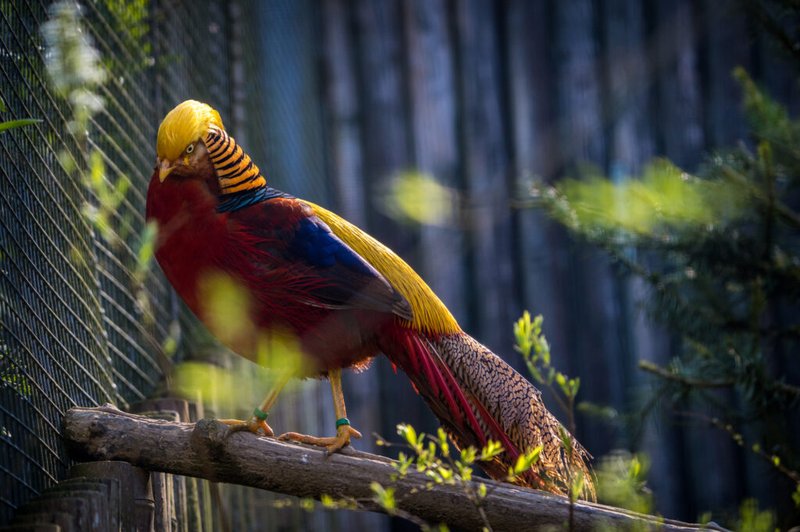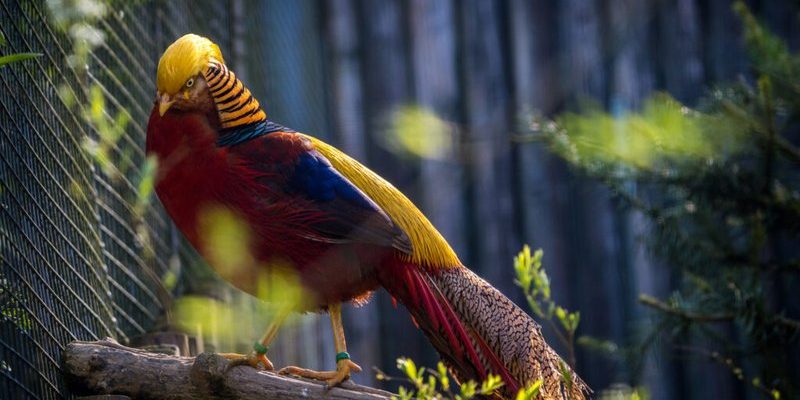
Imagine walking through a lush, green forest and suddenly spotting a flash of vibrant color darting between the trees. That’s the Golden Pheasant for you! With its striking beauty and unique traits, this bird has captured the hearts of nature lovers and birdwatchers alike. The Golden Pheasant, also known scientifically as Chrysolophus pictus, is native to the mountainous forests of China. But it’s not just their looks that make them fascinating; there’s a whole world behind their vivid plumage and enchanting behaviors.
These birds are not just about their eye-catching appearance. They’re a part of a rich ecosystem and have intriguing lifestyle habits. Whether you’re interested in their habitat, diet, or mating rituals, the Golden Pheasant is full of surprises. So, let’s dive in and explore everything you need to know about these stunning creatures!
Physical Characteristics
The Golden Pheasant is a spectacle of nature, easily recognized by its bright yellow and red feathers. Males are particularly flamboyant, boasting a golden crest and long tail feathers that can reach impressive lengths. In fact, these tail feathers can be almost three feet long! This spectacular coloration is not just for show; it plays a critical role in attracting females during mating season.
Females, on the other hand, are much more subdued in color. They have a muted brown and tan plumage, which provides excellent camouflage in their natural habitat. This difference in coloration is a classic example of sexual dimorphism, where males and females of the same species display different characteristics. The contrast makes observing their behaviors even more interesting, especially during mating displays.
Size and Weight
When it comes to size, Golden Pheasants don’t disappoint. Adult males typically measure between 32 to 35 inches long, while females are slightly smaller, averaging around 24 inches. In terms of weight, males usually weigh between 2 to 2.5 pounds, while females are around 1.5 to 2 pounds. This size difference helps them adapt to their environments. For instance, the heavier males can take on more robust branches as they move through the trees.
| Characteristic | Male | Female |
| Length | 32-35 inches | 24 inches |
| Weight | 2-2.5 pounds | 1.5-2 pounds |
| Coloration | Bright yellow and red | Brown and tan |
| Habitat | Tropical forests | Tropical forests |
| Diet | Omnivorous | Omnivorous |
Habitat and Distribution
The Golden Pheasant thrives in temperate forests, particularly in the mountainous regions of China, mainly in the western and central parts of the country. They prefer dense underbrush and are often found in areas where the trees provide ample cover. This preference helps them avoid predators while they forage for food. Interestingly, the forests where they live are not just beautiful; they are critical to their survival.
While these birds are native to China, they have also been introduced to places like the UK and New Zealand. In these regions, they often adapt well, largely due to the similar environments. In fact, spots like Britain’s woodlands have become great places for bird lovers to catch sight of them. However, introducing species to new areas can sometimes lead to unforeseen ecological impacts, so it’s a mixed bag.
Diet and Feeding Habits
You might wonder what fuels such a colorful bird! The Golden Pheasant is omnivorous, meaning they enjoy a varied diet. They primarily feed on seeds, grains, and fruits, but they also munch on insects and small animals when they get the chance. This diverse diet helps them get the necessary nutrients to maintain their vibrant feathers and energy levels.
Foraging for food usually happens in the early morning or late afternoon when they’re most active. They tend to scratch the ground with their feet to uncover seeds and other tasty treats hidden under leaves or debris. This behavior not only helps them find food but also aerates the soil, which is beneficial for the forest ecosystem.
Behavior and Social Structure
Golden Pheasants are generally solitary creatures, though they can sometimes be found in small groups, especially during the breeding season. Males are known for their vibrant displays to attract females, puffing up their feathers and showing off their bright colors. It’s a bit like a peacock’s dance, but with their unique twist. These displays can be quite elaborate, often involving loud calls and intricate movements.
While the males take center stage, females are typically more reserved. After mating, females build their nests on the ground, where they lay a clutch of around 10 to 12 eggs. Once the chicks hatch, they are precocial, meaning they are relatively mature and mobile shortly after birth. This independence helps them survive in the wild, as they can leave the nest and forage for food with their mothers.
Mating and Reproduction
The mating habits of Golden Pheasants are fascinating. During the breeding season, males become increasingly active, calling out to attract females with their bright colors and impressive displays. Mating season typically occurs in spring, and the competition can be fierce. Males will often engage in displays to establish dominance and attract females, showcasing their stunning appearance in the process.
Once a female selects a mate, she will seek out a suitable nesting site, often hidden among dense foliage. The eggs are usually laid in a simple nest made of grass and leaves. The female takes on most of the parental duties, incubating the eggs for about 21 to 24 days. After hatching, the chicks are quick to leave the nest, starting their journey toward independence almost immediately.
Conservation Status
Currently, the Golden Pheasant is classified as Least Concern by the IUCN. While they are not immediately threatened, habitat loss due to deforestation and agriculture poses ongoing challenges. As forests shrink, these beautiful birds face increasing pressure, making conservation efforts essential to ensure their continued survival. Working to preserve their habitats can help maintain the balance of the ecosystem they thrive in.
Efforts are underway in parts of their native range to protect these birds and their habitats. Local conservation groups are focusing on preserving forest areas and raising awareness about the importance of biodiversity. In many cases, educating local communities about the value of wildlife can lead to positive changes in conservation practices.
Interesting Facts
The Golden Pheasant has some quirks that make it even more captivating! For instance, did you know that they can fly short distances? Although they are primarily ground-dwelling, their wings allow them to escape predators quickly. If startled, these birds will take off into the lower branches of nearby trees, using their agility to evade danger.
Another fun fact is that the vibrant colors of the Golden Pheasant are not due to pigments but structural coloration, meaning their feathers reflect light in such a way that they appear iridescent. This fascinating phenomenon occurs because of the microscopic structures within their feathers, which can change how light interacts with them. Their colors can vary based on the angle of light, making them even more enchanting.
FAQ
What is the Golden Pheasant’s main diet?
The Golden Pheasant enjoys a varied diet that includes seeds, grains, fruits, and insects. This omnivorous diet helps them stay healthy and vibrant.
How do Golden Pheasants mate?
Mating happens during the spring. Males perform elaborate displays and calls to attract females. Once a female selects a male, she will build a nest and lay eggs, which she incubates for about three weeks.
Are Golden Pheasants good pets?
While they can be kept as pets, Golden Pheasants require a lot of space and specific care. They are best suited for experienced bird owners who can provide a suitable environment and diet.
How long do Golden Pheasants live?
In the wild, Golden Pheasants typically live up to 3-5 years, while in captivity, they can live longer with proper care, sometimes reaching over 10 years.
What do female Golden Pheasants look like?
Females are less colorful than males, sporting a subdued brown and tan plumage that helps them blend into their surroundings, which is crucial for nesting and protecting their young.
Can Golden Pheasants fly?
Yes, Golden Pheasants can fly short distances. While they spend most of their time on the ground, their wings allow them to escape from predators quickly.
Where can I see Golden Pheasants?
Golden Pheasants can be seen in their native habitats in China and in some wildlife reserves around the world, including certain parts of the UK and New Zealand where they have been introduced.

